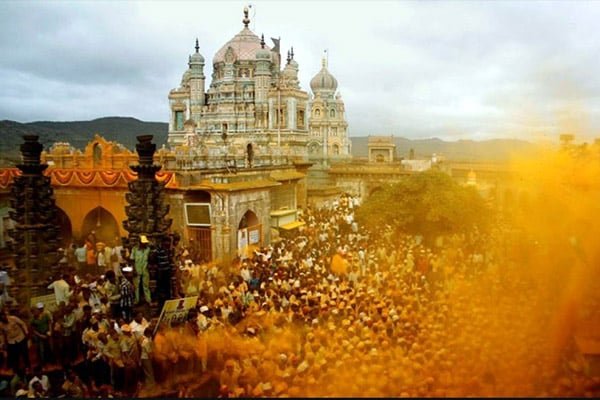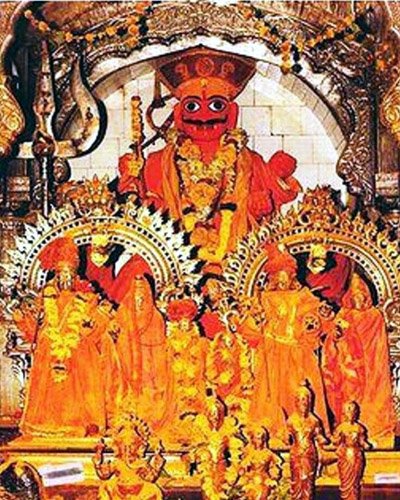Khandoba Jejuri Mandir is located in the city of Jejuri in Pune. It is the Khandoba (Marthanda Bhairava) temple’s main temple in Maharashtra. There are two shrines on a hill in Jejuri Khandoba temple: one is Kadapathar, and the other is Gad-Kot temple. Jejuri temple timings are from 5 am to 9 pm.
Jejuri Temple
Contents
Khandoba Jejuri Temple is one of the most important hill stations in Maharashtra. The temple is located 48 km southeast of Pune towards Faltan.
The 200 stone stairs lead a devotee to the Khandoba shrine on a hill. Jejuri is the abode of the ancient tribe of Dhangars, the god of Maharashtra.

The Shepherds Association is devoted to Khandoba (Lord Shiva) as he married Ganai, a shepherd’s daughter.
Married Couples visit the shrine, and a couple must make an offering to the goddess together, one next to the other. Lord Shiva appeared as Khandoba to slay the demons Mani and Malla.
Diviti is the war symbol of Khandoba. Diviti has the shape of a dagger but doubles as a lamp. The dagger is a symbol of light that kills darkness when lit.
History and Architecture
The temple was first built in 1608 AD. The hall and other parts were completed in 1637 AD by the Maratha chief Ragho Mambaji. The Holker rulers made peripheral rooms and other additions.
Tukoji added the pillars in 1742 AD, and Tukoji Holkar completed the battlefields and the tank in 1770 AD.
Chhatrapati Shivaji Maharaj met his father, Shahaji, after a long hiatus of 14 years and discussed guerrilla tactics to drive out the Mughals in the temple. Then, it was also a stronghold for the people of this region.
Devotees usually visit and worship Khandoba in the lower temple. For centuries, shepherds, who considered Khandoba their family deity, built gateways, improved staircases, lamps, cloisters, canopies, etc.

People whose desires were fulfilled also added many structures. All the additions to the original temple fit into one model of Maratha architecture.
There are minarets and canopies around the corners of the temple, and the surrounding cloisters have stone arches with grills or windows.
The temple houses an old Portuguese bell and a considerable brass-plated turtle with a diameter of 7 meters, which is used for distributing yellow and dried coconuts.
Nana Fadnavis, the Peshwa’s envoy to Pune, presented one lakh silver coins to fulfil the vow, partially converted into positive silver images and some into ornate mahirap (background).
It has three sets of sculptures (paintings) that showcase the craftsmanship of jewellers, copperworkers and other artists.
Jejuri Khandoba Temple Festivals and Jatras
Jejuri Mandir Fairs and Festivals Chang Bhale Khandobacha Yelkot – A famous hymn in the Jejuri Mandir. Throwing yellow powder in the shrine is an important ritual, and it is called Bhandara.
Jejuri Temple Khandoba – Malhari Marthand Bhairav Festival and Rathodsav – This six-day festival starts on Karthika Amavasi and ends on Champa Sashti.
During important festivals and rituals, the temple was visited by nearly a million devotees. Other important festivals and ceremonies take place during the months of Chaitra (April), Paush (January) and Magha (February).
The most famous of these is the Khandoba Shikar Khati Yatra. Monday Amavas – The new moon or moon that falls on Monday – is the most sacred in the shrine.
The Kara River flows down the hill, and the festival idol of Khandoba is submerged in the river on the Monday of Amavati Amavas.

There are many elaborate rituals associated with the Khandoba Jejuri Mandir. Baghd – In this ritual, a person fulfils his vow after fulfilling his wish after prayers in the temple. The pledge involves hanging from a pole with the help of hooks inserted into the skin on the back.
Katya, wrapped in ritual long bamboo and red turbans, is carried by the Holkar, Holam and Khaire families and touches the peak during festivals on full moon days.
Breaking the steel chain or anchor is another way to fulfil the pledge. Some devotees carry water from the river and walk on fire or ‘hull’ in a kavad ritual.
Some devotees arrange performances by dancers and musicians (Vaghya and Murali dances).
The best time to visit
There are three main seasons to visit Jejuri temple: summer, monsoons and winter.
Although the monsoons are sometimes harsh, the place enjoys a stable climate throughout the year and does not bother tourists with its tastes.
Summer (end of March – June):
Although the days are hot, they are not dry. The nights are usually not hot and pleasant. Temperatures range between 22 degrees Celsius and 36 degrees Celsius.
Monsoons (End of June – mid-September):
Monsoons are wet and heavy in Jejuri and last from late June to mid-September. It rains continuously for days. Monsoon is a good season for nature lovers to visit this place.
Winter (November – February):
The winters in this city are also mild. It is excellent sometimes but never drops below 5-8 degrees Celsius. November- February is an excellent time to visit Jejuri. Many cultural and artistic festivals take place during this time. Therefore, the best time to visit Jejuri Temple is between November and February.
Accommodation in Jejuri Khandoba Temple
- The Corinthians Resorts and Club, 33.2 km from Jejuri Temple.
- Hotel Amanara The Fern, 35.8 km from Jejuri Khandoba Temple.
- Treebo Trip Punest Hotel, 32.2 km from Jejuri Khandoba Temple.
- Jackson Inns, 35 km from Jejuri Khandoba Temple.
- The Gold Heaven is 38 km from Jejuri Khandoba Temple.
Jejuri Temple Timings
Jejuri temple timings are:
| Darshan Details | Jejuri Temple Timings |
| 9:00 pm | 5:00 am |
| Bhupali and Arthi | 5:30 a5:30 am0 am |
| Dharshan | 6:30 a6:30 am00 pm |
| Pooja and Arthi | 12:00 12:00 pm30 pm |
| Naivedya | 12:30 12:30 pm0 pm |
| Maha Prasad | 12:30 12:30 pm0 pm |
| Dharshan | 1:00 p1:00 pm5 pm |
| Prasad for devotees | 2:00 pm |
| Shej Arthi | 9:00 pm |
| Closing hours | 9:00 pm |
Entry fee details in Khandoba Jejuri Temple:
Rs 50 for Special Dharshan.
Rs 50 for Senior Citizen entry from the 1st gate itself.
How to Reach Khandoba
Air: Pune International Airport (PNQ) is the nearest airport, about 50 km away.
Rail: The JJR Railway Station (JJR) is connected well to most railway lines.
Road: Jejuri Temple is 52 km by road from Pune. Buses to Jeju are standard. Taxis are readily available in Pune.
Khandoba Temple Address
Jejuri Temple, Maharashtra 412303, India
Khandoba Temple Contact Number: +91-9850150797